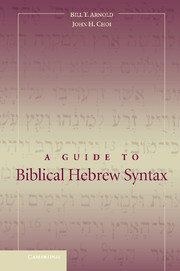1 - INTRODUCTION
Published online by Cambridge University Press: 05 June 2012
Summary
At the heart of biblical interpretation is the need to read the Bible's syntax, that is, to study the way words, phrases, clauses, and sentences relate to one another in order to create meaning. Biblical Hebrew is a language far removed from us in time and culture. Mastering it is a noble but daunting task. Students often learn to discern the elementary phonology and morphology in order to “read” the biblical text. But we believe exegesis (or the extraction of a text's meaning) requires more than phonology and verb parsing. Achieving a deep-level reading requires a grasp of a text's syntactical relationships, a topic that most beginning grammars do not present in detail. Thus, our task has been to help the reader grasp the building blocks of Biblical Hebrew, that is, the syntactical specifics that constitute meaning. These are the linguistic details through which the most profound of all statements can be made, and have been made – those of Israel's monotheism and the nation's covenant relationship with yhwh.
We have defined and illustrated the fundamental morphosyntactical features of Biblical Hebrew. The volume divides Hebrew syntax, and to a lesser extent morphology (“the way words are patterned or inflected”), into four parts. The first three cover individual words (nouns, verbs, and particles) with the goal of helping the reader move from morphological and syntactical observations to meaning and significance. The fourth section moves beyond phrase-level phenomena and considers the larger relationships of clauses and sentences.
- Type
- Chapter
- Information
- A Guide to Biblical Hebrew Syntax , pp. 1 - 3Publisher: Cambridge University PressPrint publication year: 2003



